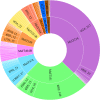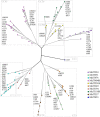Sequencing Independent Molecular Typing of Staphylococcus aureus Isolates: Approach for Infection Control and Clonal Characterization
- PMID: 35138156
- PMCID: PMC8826877
- DOI: 10.1128/spectrum.01817-21
Sequencing Independent Molecular Typing of Staphylococcus aureus Isolates: Approach for Infection Control and Clonal Characterization
Abstract
Staphylococcus aureus is a major bacterial human pathogen that causes a wide variety of clinical manifestations. The main aim of the presented study was to determine and optimize a novel sequencing independent approach that enables molecular typing of S. aureus isolates and elucidates the transmission of emergent clones between patients. In total, 987 S. aureus isolates including both methicillin-resistant S. aureus (MRSA) and methicillin-sensitive S. aureus (MSSA) isolates were used to evaluate the novel typing approach combining high-resolution melting (HRM) analysis of multilocus sequence typing (MLST) genes (mini-MLST) and spa gene (spa-HRM). The novel approach's discriminatory ability was evaluated by whole-genome sequencing (WGS). The clonal relatedness of tested isolates was set by the BURP and BURST approach using spa and MLST data, respectively. Mini-MLST classified the S. aureus isolates into 38 clusters, followed by spa-HRM classifying the isolates into 101 clusters. The WGS proved HRM-based methods to effectively differentiate between related S. aureus isolates. Visualizing evolutionary relationships among different spa-types provided by the BURP algorithm showed comparable results to MLST/mini-MLST clonal clusters. We proved that the combination of mini-MLST and spa-HRM is rapid, reproducible, and cost-efficient. In addition to high discriminatory ability, the correlation between spa evolutionary relationships and mini-MLST clustering allows the variability in population structure to be monitored. IMPORTANCE Rapid and cost-effective molecular typing tools for Staphylococcus aureus epidemiological applications such as transmission tracking, source attribution and outbreak investigations are highly desirable. High-resolution melting based methods are effective alternative to those based on sequencing. Their good reproducibility and easy performance allow prospective typing of large set of isolates while reaching great discriminatory power. In this study, we established a new epidemiological approach to S. aureus typing. This scheme has the potential to greatly improve epidemiological investigations of S. aureus.
Keywords: MLST; MRSA; MSSA; high-resolution melting; mini-MLST; spa-typing; whole-genome sequencing.
Conflict of interest statement
The authors declare no conflict of interest.
Figures




References
-
- Leopold S, Goering R, Witten A, Harmsen D, Mellmann A. 2014. Bacterial whole-genome sequencing revisited: portable, scalable, and standardized analysis for typing and detection of virulence and antibiotic resistance genes. J Clin Microbiol 52:2365–2370. doi:10.1128/JCM.00262-14. - DOI - PMC - PubMed
-
- Roisin S, Gaudin C, De Mendonça R, Bellon J, Van Vaerenbergh K, De Bruyne K, Byl B, Pouseele H, Denis O, Supply P. 2016. Pan-genome multilocus sequence typing and outbreak-specific reference-based single nucleotide polymorphism analysis to resolve two concurrent Staphylococcus aureus outbreaks in neonatal services. Clin Microbiol Infect 22:520–526. doi:10.1016/j.cmi.2016.01.024. - DOI - PubMed
Publication types
MeSH terms
LinkOut - more resources
Full Text Sources
Medical

